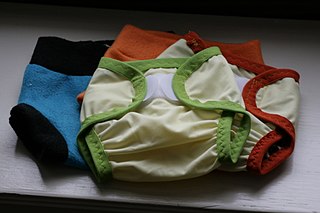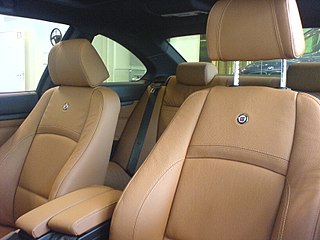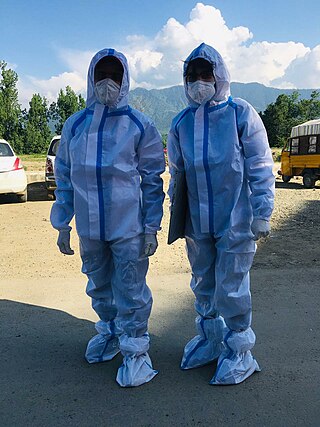Flooring is the general term for a permanent covering of a floor, or for the work of installing such a floor covering. Floor covering is a term to generically describe any finish material applied over a floor structure to provide a walking surface. Both terms are used interchangeably but floor covering refers more to loose-laid materials.

Formica Laminate is a laminated composite material invented at the Westinghouse Electric Corporation in the United States in 1912. Originally used to replace mica in electrical applications, it has since been manufactured for multiple applications. It has been produced by Formica Group manufacturing sites across the globe since. Formica Group are best known for the company's classic product: a heat-resistant, wipe-clean laminate of paper with melamine resin.

Lamination is the technique/process of manufacturing a material in multiple layers, so that the composite material achieves improved strength, stability, sound insulation, appearance, or other properties from the use of the differing materials, such as plastic. A laminate is a layered object or material assembled using heat, pressure, welding, or adhesives. Various coating machines, machine presses and calendering equipment are used.

Upholstery is the work of providing furniture, especially seats, with padding, springs, webbing, and fabric or leather covers. The word also refers to the materials used to upholster something.

Polyvinyl butyral is a resin mostly used for applications that require strong binding, optical clarity, adhesion to many surfaces, toughness and flexibility. It is prepared from polyvinyl alcohol by reaction with butyraldehyde. The major application is laminated safety glass for automobile windshields. Trade names for PVB-films include KB PVB, GUTMANN PVB, Saflex, GlasNovations, Butacite, WINLITE, S-Lec, Trosifol and EVERLAM. PVB is also available as 3D printer filament that is stronger and more heat resistant than polylactic acid (PLA).
Tolex is a trade name for a flexible, waterproof, vinyl material used as a cover material for books, upholstery, guitar amplifiers, cases, and other products.

Artificial leather, also called synthetic leather, is a material intended to substitute for leather in upholstery, clothing, footwear, and other uses where a leather-like finish is desired but the actual material is cost prohibitive or unsuitable due to practical or ethical concerns. Artificial leather is known under many names, including leatherette, imitation leather, faux leather, vegan leather, PU leather (polyurethane), and pleather.
Arborite is the leading Canadian manufacturer of high-pressure decorative plastic laminates (HPL). Best known as a counter top surfacing material, this laminate is a durable decorative veneer applied to cabinetry, furniture, and other horizontal and vertical surfaces. The original Arborite material was developed in 1942 by the Howard Smith Paper Company as an innovative way to utilize waste by-products of the Canadian papermaking industry, and to this day any laminate used for the same purpose is commonly referred to in Canada by the trade name Arborite.

Nonwoven fabric or non-woven fabric is a fabric-like material made from staple fibre (short) and long fibres, bonded together by chemical, mechanical, heat or solvent treatment. The term is used in the textile manufacturing industry to denote fabrics, such as felt, which are neither woven nor knitted. Some non-woven materials lack sufficient strength unless densified or reinforced by a backing. In recent years, non-wovens have become an alternative to polyurethane foam.

Polyurethane laminate is a compound fabric made by laminating a cloth fabric to one or both sides of a thin film of polyurethane. Polyurethane laminated fabrics have a wide range of applications in medical, automotive and garment uses.

Alcantara is the brand name of a synthetic textile with a soft, suede-like microfibre pile, noted for its durability. Alcantara was developed in the 1970s by Miyoshi Okamoto and initially manufactured by the Italian company Alcantara. The term has an Arabic root and means "the bridge".

Bonded leather, also called reconstituted leather, composition leather or blended leather, is a term used for a manufactured upholstery material which contains animal hide. It is made as a layered structure of a fiber or paper backer covered with a layer of shredded leather fibers mixed with natural rubber or a polyurethane binder that is embossed with a leather-like texture.

Decorative concrete is the use of concrete as not simply a utilitarian medium for construction but as an aesthetic enhancement to a structure, while still serving its function as an integral part of the building itself such as floors, walls, driveways, and patios.

Ultrasuede is the trade name for a synthetic ultra-microfiber fabric invented in 1970 by Dr. Miyoshi Okamoto, a scientist working for Toray Industries. In Japan, it is sold under the brand name Ecsaine. It is often described as an artificial substitute for suede leather. The fabric is multifunctional: it is used in fashion, interior decorating, automobile and other vehicle upholstery, and industrial applications, such as protective fabric for electronic equipment. It is also a very popular fabric in the manufacture of footbags and juggling balls. Other manufacturers such as Sensuede and Majilite also produce similar product lines of synthetic microfiber suede.

Wood flooring is any product manufactured from timber that is designed for use as flooring, either structural or aesthetic. Wood is a common choice as a flooring material and can come in various styles, colors, cuts, and species. Bamboo flooring is often considered a form of wood flooring, although it is made from bamboo rather than timber.
A fabric structure is a structure made of fabric, with or without a structural frame made from the weaving of the fabric itself. The technology provides end users a variety of aesthetic free-form building designs. Custom-made structures are engineered and fabricated to meet worldwide structural, flame retardant, weather-resistant, and natural force requirements. Fabric structures are considered a sub-category of tensile structure.

Synthomer plc, formerly known as Yule Catto & Co, is a British-based chemicals business. It is listed on the London Stock Exchange.

An Automotive textile is a technical textile used in the transportation and automotive industries. The choice of type of automotive textile focuses on aspects of safety, comfort, and aesthetics. These textiles have variety of applications in the automotive industry, such as interior fittings, safety features, sound insulation, and tire reinforcement.

Coated fabrics are those that have undergone a coating procedure to become more functional and hold the added properties, such as cotton fabrics becoming impermeable or waterproof. Coated textiles are used in a variety of applications, including blackout curtains and the development of waterproof fabrics for raincoats.
















